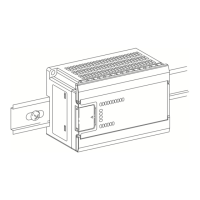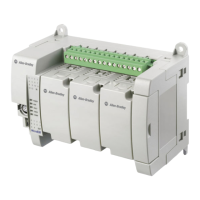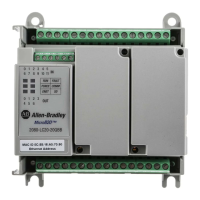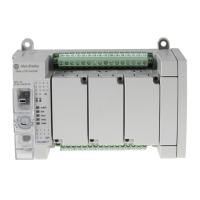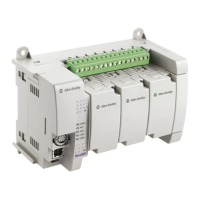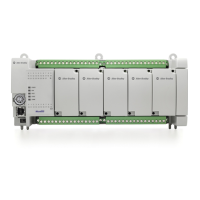Publication 1763-RM001B-EN-P - April 2007
342 Communications Instructions
• Communications Buffers
• Communication Queue
These three components determine when a message is transmitted by the
controller. For a message to transmit, it must be scanned on a true rung of
logic. When scanned, the message and the data defined within the
message (if it is a write message) are placed in a communication buffer.
The controller continues to scan the remaining user program. The
message is processed and sent out of the controller via the
communications port after the ladder logic completes, during the Service
Communications part of the operating cycle, unless an SVC is executed.
If a second message instruction is processed before the first message
completes, the second message and its data are placed in one of the three
remaining communication buffers. This process repeats whenever a
message instruction is processed, until all four buffers are in use.
When a buffer is available, the message and its associated data are placed
in the buffer immediately. If all four buffers for the channel are full when
the next (fifth) message is processed, the message request, not the data, is
placed in the channel’s communications queue. The queue is a message
storage area that keeps track of messages that have not been allocated a
buffer. The queue operates as a first-in first-out (FIFO) storage area. The
first message request stored in the queue is the message that is allocated a
buffer as soon as a buffer becomes available. The queue can
accommodate all MSG instructions in a ladder program.
When a message request in a buffer is completed, the buffer is released
back to the system. If a message is in the queue, that message is then
allocated a buffer. At that time, the data associated with the message is
read from within the controller.
The buffer and queue mechanisms are completely automatic. Buffers are
allocated and released as the need arises, and message queuing occurs if
buffers are full.
The controller initiates read and write messages through available
communication channels when configured for the following protocols:
• DH-485
• DF1 Full-Duplex
TIP
If a message instruction was in the queue, the data that is
actually sent out of the controller may be different than
what was present when the message instruction was first
processed.
efesotomasyon.com - Allen Bradley,Rockwell,plc,servo,drive
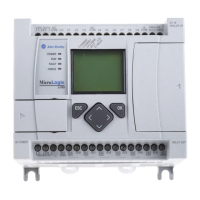
